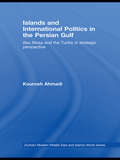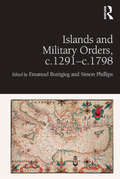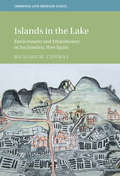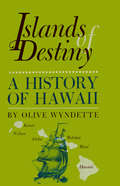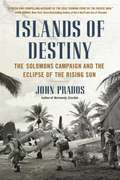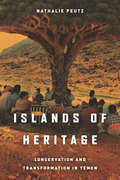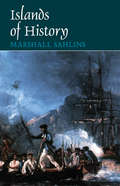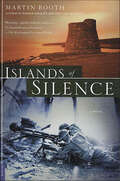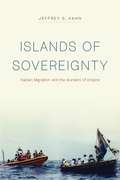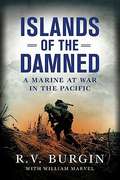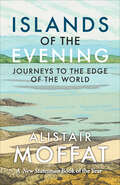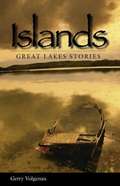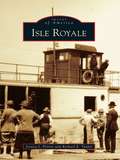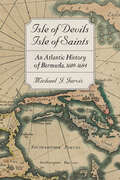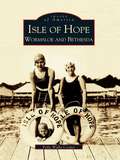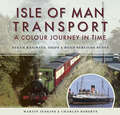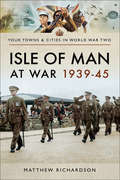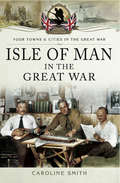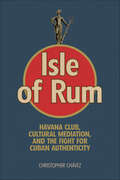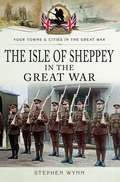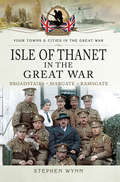- Table View
- List View
Islands and International Politics in the Persian Gulf: The Abu Musa and Tunbs in Strategic Context (Durham Modern Middle East and Islamic World Series)
by Kourosh AhmadiThe position of the Persian Gulf as the main highway between East and West has long given this region special significance both within the Middle East and in global affairs more generally. This book examines the history of international relations in the Gulf since the 1820s as great powers such as Britain and the US, and regional powers such as Iran and Iraq, vied for supremacy over this geopolitically vital region. It focuses on the struggle for control over the islands of the Gulf, in particular the three islands of Abu Musa, Greater Tunb and Lesser Tunb – an issue that remains highly contentious today. It describes how for 170 years Britain eroded Iranian influence in the Gulf, both directly by asserting colonial rule over Iranian islands and port districts, and also through claiming Iranian islands for their protégés on the Arab littoral. It shows how, after Britain's withdrawal, these islands became a pawn in the animosity and conflict that pitted, at one time, Arab radicals and nationalists against monarchical Iran, and, later, the conservative-moderate Arab camp against Islamic Iran. It goes on to explore the impact of the rise of American power in the Gulf since the start of the 1990s, its policy of containment of Iran and Iraq, and how this has provided encouragement to the ambitions of the Persian Gulf Arab littoral states, especially the UAE, towards the islands of the Gulf.
Islands and Military Orders, c.1291-c.1798
by Simon Phillips Emanuel ButtigiegAt the heart of this volume is a concern with exploring levels of interaction between two particular objects of study, islands on the one hand, and military orders on the other. According to Fernand Braudel, islands are, ’often brutally’, caught ’between the two opposite poles of archaism and innovation.’ What happened when these particular environments interacted with the Military Orders? The various contributions in this volume address this question from a variety of angles. 1291 was a significant year for the main military orders: uprooted from their foundations in the Holy Land, they took refuge on Cyprus and in the following years found themselves vulnerable to those who questioned the validity of their continued existence. The Teutonic Order negated this by successfully transferring their headquarters to Prussia; the Knights Templar, however, faced suppression. Meanwhile, the Knights Hospitaller conquest of Rhodes assured both their survival and independence. Islands are often, by definition, seen to be embodiments of 'insularity', of an effort to be separate, distinct, cut-off. Military Orders are, conversely, international in scope, nature and personnel, the 'first international orders of the Church', as they have often been described. Therein lies the crux of the matter: how did insular outposts and international institutions come together to forge distinct and often successful experiments? Hospitaller Rhodes and Malta still impress with their magnificent architectural heritage, but their success went beyond stone and mortar and the story of islands and military orders, as will be clearly shown in this volume, also goes beyond these two small islands. The interaction between the two levels - insulation and internationalisation - and the interstices therein, created spaces conducive to both dynamism and stability as military orders and islands adapted to each other's demands, limitations and opportunities.
Islands in the Lake: Environment and Ethnohistory in Xochimilco, New Spain (Cambridge Latin American Studies)
by Richard M. ConwayNow notorious for its aridity and air pollution, Mexico City was once part of a flourishing lake environment. In nearby Xochimilco, Native Americans modified the lakes to fashion a distinctive and remarkably abundant aquatic society, one that provided a degree of ecological autonomy for local residents, enabling them to protect their communities' integrity, maintain their way of life, and preserve many aspects of their cultural heritage. While the area's ecology allowed for a wide array of socioeconomic and cultural continuities during colonial rule, demographic change came to affect the ecological basis of the lakes; pastoralism and new ways of using and modifying the lakes began to make a mark on the watery landscape and on the surrounding communities. In this fascinating study, Conway explores Xochimilco using native-language documents, which serve as a hallmark of this continuity and a means to trace patterns of change.
Islands of Destiny: A History of Hawaii
by Olive WyndetteIt is the fast-moving narrative of an island nation whose settlement antedates the arrival of European pioneers by a thousand years, and whose destiny it was to become the fiftieth star in the flag of the United States of America.<P><P> It tells how the Islanders have created a modern-day miracle through education, economic progress, and financial growth in the past 150 years.Olive Wyndette became fascinated by personal contacts with the native Hawaiians during her residence in Honolulu and, as a result, planned this book on the living history of Hawaii.The little-known but dramatic story of the prehistoric period is told in the Prologue. The ensuring text tells how Captain James Cook discovers the Islands, naming them after the Earl of Sandwich. Kamehameha I (the Conqueror) rises to power and unifies the islands through a series of bloody, inter-Island wars. The New England missionaries arrive and are eventually permitted to build the Islands' first Christian church. Following the establishment of a constitutional government, the Islands become the coveted prize of powerful European nations. Finally, annexation of the Islands to the United States is realized in 1898. The Epilogue covers the developments of the twentieth century.
Islands of Destiny: The Solomons Campaign and the Eclipse of the Rising Sun
by John PradosAcclaimed WWII historian and military intelligence expert John Prados offers a provocative reassessment of the Allies’ battle for the Solomon Islands—a turbulent, dramatic campaign that, he argues, was the true turning point of the Pacific conflict. Historians traditionally refer to the Battle of Midway as the point when Allied forces gained the advantage over the Japanese. In Islands of Destiny, Prados points out that the Japanese forces quickly regained strength after Midway and continued their assault undaunted. Taking this surprising fact as the start of his inquiry, he began to investigate how and when the Pacific tide turned in the Allies’ favor. His search led him to the decisive battles and strategic maneuvers in the fight for the Solomon Islands. Beginning with the invasion of Guadalcanal in August 1942, the Solomons became a hotly contested battleground for over a year, culminating in the isolation of Rabaul by the Allies. As military forces fought over the strategically important islands, a secret war of intelligence was also being waged. For a total picture of the conflict, Prados integrates blow-by-blow action on the ground with the code breaking, aerial reconnaissance, secret spy posts, and submarine scouting that were vital to the Allied effort. The Solomons arena saw some of the most intense combat of WWII—from major naval actions, including a key confrontation between battleships, to air battles that took place almost daily. With expert knowledge and crystal clear prose, John Prados illustrates why these events were not only thrilling, but pivotal in the Allies’ path to victory. .
Islands of Heritage: Conservation and Transformation in Yemen
by Nathalie PeutzSoqotra, the largest island of Yemen's Soqotra Archipelago, is one of the most uniquely diverse places in the world. A UNESCO natural World Heritage Site, the island is home not only to birds, reptiles, and plants found nowhere else on earth, but also to a rich cultural history and the endangered Soqotri language. Within the span of a decade, this Indian Ocean archipelago went from being among the most marginalized regions of Yemen to promoted for its outstanding global value. Islands of Heritage shares Soqotrans' stories to offer the first exploration of environmental conservation, heritage production, and development in an Arab state. Examining the multiple notions of heritage in play for twenty-first-century Soqotra, Nathalie Peutz narrates how everyday Soqotrans came to assemble, defend, and mobilize their cultural and linguistic heritage. These efforts, which diverged from outsiders' focus on the island's natural heritage, ultimately added to Soqotrans' calls for political and cultural change during the Yemeni Revolution. Islands of Heritage shows that far from being merely a conservative endeavor, the protection of heritage can have profoundly transformative, even revolutionary effects. Grassroots claims to heritage can be a potent form of political engagement with the most imminent concerns of the present: human rights, globalization, democracy, and sustainability.
Islands of History
by Marshall SahlinsMarshall Sahlins centers these essays on islands--Hawaii, Fiji, New Zealand--whose histories have intersected with European history. But he is also concerned with the insular thinking in Western scholarship that creates false dichotomies between past and present, between structure and event, between the individual and society. Sahlins's provocative reflections form a powerful critique of Western history and anthropology.
Islands of History: Structure In The Early History Of The Sandwich Islands Kingdom (Asao Special Publications; Ser.)
by Marshall SahlinsMarshall Sahlins centers these essays on islands—Hawaii, Fiji, New Zealand—whose histories have intersected with European history. But he is also concerned with the insular thinking in Western scholarship that creates false dichotomies between past and present, between structure and event, between the individual and society. Sahlins's provocative reflections form a powerful critique of Western history and anthropology.
Islands of Resistance: Puerto Rico, Vieques, and U.S. Policy (Open Media Series)
by Mario MurilloWhile 1998 marked the 100th anniversary of the United States' invasion and takeover of Puerto Rico, it wasn't until 1999 that the island's political movements reappeared on the radar screen of the American people. That year, two major developments occurred that transformed the relationship between Puerto Rico and Washington, D.C.: the limited clemency granted by then-President Clinton to eleven Puerto Rican Nationalists, and the death of Puerto Rican civilian security guard David Sanes, killed by missile fragments from U.S. naval bombing tests on the island municipality of Vieques.How does Vieques fit into the political future of Puerto Rico? While anti-Navy protesters are careful not to mix the island's political status options with their battle against the Navy, it is important to understand the role Washington has played in shaping Puerto Rico's current reality and how it has allowed the Navy to use Vieques as a bombing range for 60 years. It also helps one begin to predict what is the future of Puerto Rico. Is it to be a colony? Fifty-first state of the United States? Sovereign nation?In Islands of Resistance, Mario A. Murillo approaches these questions by examining how Puerto Rican politics have been shaped as much by 100 years of U.S. economic, military, and cultural domination of the territory, as by the enduring grassroots resistance of the Puerto Rican people. Islands of Resistance puts the contemporary situation in Puerto Rico into an historic context that will help people understand what is at stake in Vieques, not only for Viequenses, but for Puerto Ricans, both on the island and in the diaspora.
Islands of Silence: A Novel
by Martin BoothIslands of Silence is the story of the young Alec Marquand, who in the summer of 1914 has just graduated from college with a degree in archaeology. He has been hired by the lord of a remote country estate in the Scottish Highlands to survey the ancient Stone Age brochs that lie on his property. Once there Alec comes upon a small island which is called Eilean Tosdach--the Island of Silence. What Alec discovers on that island changes him forever. And just as Alec makes his amazing find, he is shipped off to war . . . a war he does not want to fight, but one in which he ends up as a medic aboard a ship ready to storm the beaches of Gallipoli.A brilliantly crafted novel in the tradition of All's Quiet on the Western Front and The Ghost Road, Islands of Silence is a tour through one man's hell in search of a path for redemption.
Islands of Sovereignty: Haitian Migration and the Borders of Empire (Chicago Series in Law and Society)
by Jeffrey S. KahnIn Islands of Sovereignty, anthropologist and legal scholar Jeffrey S. Kahn offers a new interpretation of the transformation of US borders during the late twentieth century and its implications for our understanding of the nation-state as a legal and political form. Kahn takes us on a voyage into the immigration tribunals of South Florida, the Coast Guard vessels patrolling the northern Caribbean, and the camps of Guantánamo Bay—once the world’s largest US-operated migrant detention facility—to explore how litigation concerning the fate of Haitian asylum seekers gave birth to a novel paradigm of offshore oceanic migration policing. Combining ethnography—in Haiti, at Guantánamo, and alongside US migration patrols in the Caribbean—with in-depth archival research, Kahn expounds a nuanced theory of liberal empire’s dynamic tensions and its racialized geographies of securitization. An innovative historical anthropology of the modern legal imagination, Islands of Sovereignty forces us to reconsider the significance of the rise of the current US immigration border and its relation to broader shifts in the legal infrastructure of contemporary nation-states across the globe.
Islands of the Damned: A Marine at War in the Pacific
by Burgin R. V.One of the real-life heroes featured in HBO(r)'s The Pacific tells his own true story. R. V. Burgin reveals his experiences as a Marine at war in the Pacific Theater, where Company K confronted snipers, ambushes along narrow jungle trails, abandoned corpses of hara-kiri victims, and howling banzai attacks as they island-hopped from one bloody battle to the next. During his two years of service, Burgin rose from a green private to a seasoned sergeant, and earned a Bronze Star for his valor at Okinawa. With unforgettable drama and an understated elegance, Burgin's gripping narrative chronicles the waning days of World War II, bringing to life the hell that was the Pacific War. .
Islands of the Evening: Journeys to the Edge of the World
by Alistair Moffat[an] exploration of Scotland's past through the eyes of a scholarly hiker ... Magnificent' - New Statesman, Books of the Year Fourteen centuries ago, Irish saints journeyed to the Hebrides and Scotland's Atlantic shore. They sought spiritual solitude in remote places, but their mission was also to spread the word of God to the peoples of Scotland. Columba was the most famous of these pioneers who rowed their curraghs towards danger and uncertainty in a pagan land, but the many others are now largely forgotten. Alistair Moffat sets off in search of these elusive figures. As he follows in their footsteps, he finds their traces not so much in tangible remains as in the spirit and memory of the places that lay at the very edge of their world.
Islands: Great Lakes Stories
by Gerry VolgenauMost people are stunned to learn that there are some 35,000 islands in the Great Lakes, ranging from a large stone with its top above water level to the world's largest freshwater island, Manitoulin. Islands: Great Lakes' Stories focuses on 18 of these islands with their histories and personalities.
Isle Royale
by Richard E. Taylor Jessica J. PoyerThis history of Isle Royale traces almost 5,000 years of human efforts to harvest its natural resources. From the Paleo-Indians who extracted native copper to the 19th-century miners, fishermen, farmers, and sportsmen, this isle apart has been visited, mined, and plundered for centuries. Under the protection of the National Park Service since 1940, the island is returning to the natural regime that preceded the arrival of the first humans. Moose, wolves, and bald eagles now share the island with low-impact campers and boaters. The reader will visit the lighthouses, steamships, fish camps, and resorts and the people of the last two centuries who left their footprints on this jewel of Lake Superior.
Isle of Devils, Isle of Saints: An Atlantic History of Bermuda, 1609–1684 (Early America: History, Context, Culture)
by Michael J. JarvisHow can the small, isolated island of Bermuda help us to understand the early expansion of English America?First discovered by Europeans in 1505, the island of Bermuda had no indigenous population and no permanent European presence until the early seventeenth century. Settled five years after Virginia and eight years before Plymouth, Bermuda is a foundational site of English colonization. Its history reveals strikingly different paths of potential colonial development as a place where slave-owning puritan tobacco planters raised large families, engaged overseas markets, built ships, created a Christian commonwealth, hanged witches, wrestled to define racial difference, and welcomed godly pirates raiding Spanish America. In Isle of Devils, Isle of Saints, Michael J. Jarvis presents readers with a new narrative social and cultural history of Bermuda. Adopting a holistic, multidisciplinary approach that draws upon thirty years of research and archaeological fieldwork, Jarvis recounts Bermuda's turbulent, dynamic past from the Sea Venture's dramatic 1609 shipwreck through the 1684 dissolution of the Bermuda Company. He argues that the island was the first of England's colonies to produce a successful staple, form a stable community, turn a profit, transplant civic institutions, and harness bound African knowledge and labor. Bermuda was a tabula rasa that fired the imaginations of English thinkers aspiring to create an American utopia. It was also England's first puritan colony, founded as a covenanted Christian commonwealth in 1612 by self-consciously religious settlers who committed themselves to building a moral society. By the 1670s, Bermuda had become England's most densely populated possession and was poised to become an intercolonial maritime hub after freeing itself from its antiquated parent company. The first scholarly monograph in eighty years on this important, neglected colony's first century, Isle of Devils, Isle of Saints is a worthy prequel to In the Eye of All Trade, Jarvis's masterful first book. Revealing the dynamic interplay of race, gender, slavery, and environment at the dawn of English America, Jarvis's work challenges us to rethink how Europeans and Africans became distinctly American within the crucible of colonization.
Isle of Hope: Wormsloe and Bethesda
by Polly Wylly CooperIsle of Hope, Georgia, nine miles south of Savannah, is a charming settlement with a story reaching back into the 1700s. Visitors to the area marvel at scenic views along the Skidaway River, grand homes built by early Savannahians, numerous historic sites, abundant wildlife, and water sports. This treasured lifestyle is one that islanders have waged heated battles to protect, and their collective experience is celebrated within the pages of this impressive pictorial volume. An original land grant from King George II of England, photographs of early families, streetcars, Barbee's Pavilion, the original Mysterious Santa Claus, sailboat racing, and more are among the many notable items included in Isle of Hope, Wormsloe, and Bethesda. Wormsloe Plantation, home of Noble Jones built on land leased from the trustees of the colony of Georgia in 1736, is highlighted here, as well as the nearby community of Dutch Island, where Matthew Batson conducted his legendary aero-yacht experiments in 1913. Bethesda, founded in 1740 by Rev. George Whitefield and now America's oldest existing home for boys, comes to life in vintage photographs and a touching poem written by an orphan in 1917. Images culled from both public and private collections evoke memories of a way of life almost extinct in today's frantic world-a way of life held steadfast by the residents of this singular Georgia community.
Isle of Man Transport: Steam Railways, Ships, and Road Services Buses
by Martin Jenkins Charles RobertsThis stunning selection of color views, dating from the period 1953-1980, includes most of the vessels operated during this period by the Isle of Man Steam Packet Company and The Ramsey Steamship Company. Passenger boats and freighters are seen at ports on the island and on the mainland. There is comprehensive coverage of the Peel, Ramsey and Port Erin lines operated by the Isle of Man Railway with some outstanding views taken during the 1950s, together with excellent portraits of most of the locomotives, as well carriages, vans, wagons, lorries, stations, staff and signal boxes. Also covered are Douglas Station and its environs, St John's junction and the Sunday 'specials' to Braddan. Many of the rich mix of bus types operated by the railway subsidiary, Isle of Man Road Services, are seen in a variety of locations. Included are some of the vehicles delivered just before and shortly after the Second World War. There are good views of the fascinating Ramsey Pier Tramway and its unusual rolling stock, as well as rare scenes taken as early as 1953 on the Groudle Glen Railway. For anyone who loves the Isle of Man and its wealth of vintage transport, this book provides a remarkable trip down memory lane and a colorful reminder of some of its lost glories. The book is dedicated to the memory of John McCann who took brilliant color views on the island starting in 1953.
Isle of Man at War, 1939–45 (Your Towns And Cities In World War Two Ser.)
by Matthew RichardsonIsle of Man at War 1939-45 presents the remarkable story of the Manx people, and their homeland, in the most destructive conflict of the twentieth century. Few people are now aware of the extraordinary role that this small island played in assisting the allied war effort. Yet for six years, a place best known for motorcycle racing and as a holiday playground became a heavily armed fortress. Hundreds of airmen, soldiers and sailors were trained in readiness for combat. Thousands of enemy aliens were imprisoned behind the barbed wire of its camps, alongside those of British birth who were deemed to be a threat to security. Top secret radar was developed, and the Island's merchant fleet played a vital role at Dunkirk and D-Day. On battlefields around the world, gallant Manxmen fought bravely, whilst at home, in spite of the pressures which total war brought to society, there was a perhaps surprising tolerance for those with pacifist beliefs. Likewise, though there was increased government control in almost all areas of life, these were times of great advancement for Manx democracy. The story is told in the words of those who were there - some of these eyewitnesses speaking for the first time about their experiences, and among them the last survivors of that generation. Their accounts bring a freshness and immediacy to this remarkably vivid narrative.
Isle of Man in the Great War (Your Towns & Cities in the Great War)
by Caroline SmithIn August 1914, the Isle of Man was in the middle of a very successful summer season. The tourist industry was crucial to the island, but suddenly holiday-makers left and the Steam Packet vessels that normally brought them were requisitioned. The future was uncertain for those who relied on the season and their pleas for assistance were ignored. For some, the cost of living became impossibly high and without the welfare measures that had been brought about in Britain, many faced destitution. Others however, particularly farmers and those involved with the internment camps, would find war very profitable. The divisions between rich and poor grew creating much social disaffection and a bitter battle for reform was fought. As arguments raged over conscription, taxation, the economy and the housing of enemy aliens, the personalities of the period came to prominence. The unprecedented scenes of direct action and several dramatic court cases are brought to life in this account of how the island began its path to progress.The Isle of Man played an important role in World War One, supplying troops and vessels and running special camps for the internment of enemy. 8,261 men enlisted in the armed forces, which was 82.3% of the Isle of Man's male population of military age. Of these, 1,165 gave their lives and 987 were wounded.The experience of war significantly impacted on the Island, from the initial enthusiasm for sorting out the German Kaiser in time for Christmas 1914, to the gradual realization of the enormity of human sacrifice the families of the Isle were committed to as the war stretched out over the next four years. The Great War affected everyone. At home there were wounded soldiers in military hospitals, refugees from Belgium and later on German prisoners of war. There were food and fuel shortages and disruption to schooling. The role of women changed dramatically and they undertook a variety of work undreamed of in peacetime. Extracts from contemporary letters reveal their heroism and give insights into what it was like under battle conditions.
Isle of Rum: Havana Club, Cultural Mediation, and the Fight for Cuban Authenticity
by Christopher ChávezFocusing on Havana Club rum as a case study, Isle of Rum examines the ways in which Western cultural producers, working in collaboration with the Cuban state, have assumed responsibility for representing Cuba to the outside world. Christopher Chávez focuses specifically on the role of advertising practitioners, musicians, filmmakers, and visual artists, who stand to benefit economically by selling an image of Cuba to consumers who desperately crave authentic experiences that exist outside of the purview of the marketplace. Rather than laying claim to authentic Cuban culture, Chávez explores which aspects of Cuban culture are deemed most compelling and, therefore, most profitable by corporate marketers. As a joint venture between the Cuban state and Pernod Ricard, a global spirits marketer based in Paris, Havana Club embodies the larger process of economic reform, which was meant to reintegrate Cuba into global markets during Cuba’s Special Period in a Time of Peace.
Isle of Shadows
by Tracy L. HigleyRevised and updated from the original, Christy-award finalist Shadow of Colossus.Enslaved in a World of Money and Power, Tessa Dares to be Free.Raised as courtesan to wealthy and powerful men, Tessa of Delos serves at the whim of her current patron, the politician Glaucus. After ten years with him, Tessa has abandoned all desire for freedom or love, choosing instead to lock her heart away.But when Glaucus meets a violent death in his own home, Tessa grasps at a fragile hope. Only she knows of his death. If she can keep it a secret long enough, she can escape.Tessa throws herself on the mercy of the Greek god Helios, but finds instead unlikely allies in Nikos, a Greek slave, and Simeon, Glaucus's Jewish head servant. As Simeon introduces her to a God unlike any she has ever known and Nikos begins to stir feelings she had thought long dead, Tessa fights to keep her heart protected.As an assassination plot comes to light, Tessa must battle for her own freedom--and for those to whom she has begun to open her heart--as forces collide that shatter the island's peace.". . . Readers will find much to enjoy here: fine writing, suspense, mystery, faith, love, and a new look at an old story." --Publishers Weekly (for Garden of Madness)
Isle of Sheppey in the Great War (Your Towns And Cities In The Great War Ser.)
by Stephen WynnThe Isle of Sheppey, although not a heavily populated area, played an extremely important part in Great Britains war effort on the home front throughout the four and a half years of the First World War. In doing so, Sheppey provided protection for the Thames Estuary, the River Medway and the naval shipyards at both Sheerness and Chatham. Its defensive emplacements largely responsible for acquiring the nickname locally of the 'Barbed Wire Island.'One of its main claims to fame in relation to the years of the First World War would have undoubtedly been in relation to aviation. The island had been a hive of activity in relation to flying since the beginning of the twentieth century, when the Royal Aero Club came to Leysdown, making it the first airfield in England. What became Eastchurch Aerodrome was where the first pilots of the Royal Naval Air Service were trained, making it the first military flying school in the country. The Short brothers also had an aircraft factory at Eastchurch where they designed and built their own aircraft, some of which would be used during the First World War.The Isle of Sheppey also boasted another aircraft factory, which was situated at Shellbeach on the east coast of the island, an emergency landing strip at Harty on the south east side of the island, and a balloon station at Sheerness.The First World War certainly saw the Isle of Sheppey rise to the occasion and add to its long and illustrious military history. The part it played went a long way in enhancing the islands reputation of having a dogged determination to do what needed to be done for the greater good in the nations time of need.
Isle of Thanet in the Great War: Broadstairs—Margate—Ramsgate (Your Towns And Cities In The Great War Ser.)
by Stephen WynnBecause of the geographical location of the Isle of Thanet, it was always going to play a part in the First World War. For some wounded British and Commonwealth troops returning from the fighting in France and Belgium, it was their first sight of England in months. The Isle of Thanet just happened to be on one of the routes German Zeppelins and Gotha Bombers took on their way to try and bomb London, which meant that parts of the district were always going to be vulnerable from a sudden and unexpected attack from the air.The Isle of Thanet not only provided thousands of men for service in the armed forces, but hundreds of men and women to serve in the Voluntary Aid Detachments that were greatly needed, not just throughout the Isle of Thanet, but all over Kent, to help deal with the steady influx of returning wounded soldiers from across the English Channel.Members of local Territorial units, the 4th Battalion, The Buffs (East Kent Regiment) and the 3rd (Kent) Battalion, Royal Field Artillery, were quickly mobilized for war time service, during the early days of the war, suddenly making everything so very real for those concerned.Many of the districts Police Constables, were ex-servicemen, some of whom were still on the Army Reserve, they too were called up to once again go and serve with the colors.There was a great clamor across the country with everybody wanting to do their bit in what ever way they could, the people of the Isle of Thanet were no different. By the end of the war, they had certainly played their part in ensuring that the outcome was a victorious one, making the sadness of the ones who had paid the ultimate price, slightly easier to accept.
Isle of Wight in the Great War (Your Towns & Cities in the Great War)
by M. J. TrowThe Isle of Wight went to war in August 1914 along with the rest of Britain. German waiters were arrested. The tourist trade slumped. Foreigners were denounced and lads from all walks of life flocked to the Colours. Then came privations, losses, hospitals full of the sick and crippled. After conscription was brought in tribunals were set up to catch draft-dodgers. Thousands of pounds were raised for the war effort and lectures, rallies and the local press all did their bit to keep morale high. There are no official figures for the Island's war dead, but 300 of the Isle of Wight Rifles fell on one day at Gallipoli in August 1915.The original plan to commemorate the dead was to erect a cross in Winchester but that changed so that every Island parish had a memorial of its own. Ex-Islanders from as far away as Australia and Canada volunteered to fight for king and country in this war to end all wars.
